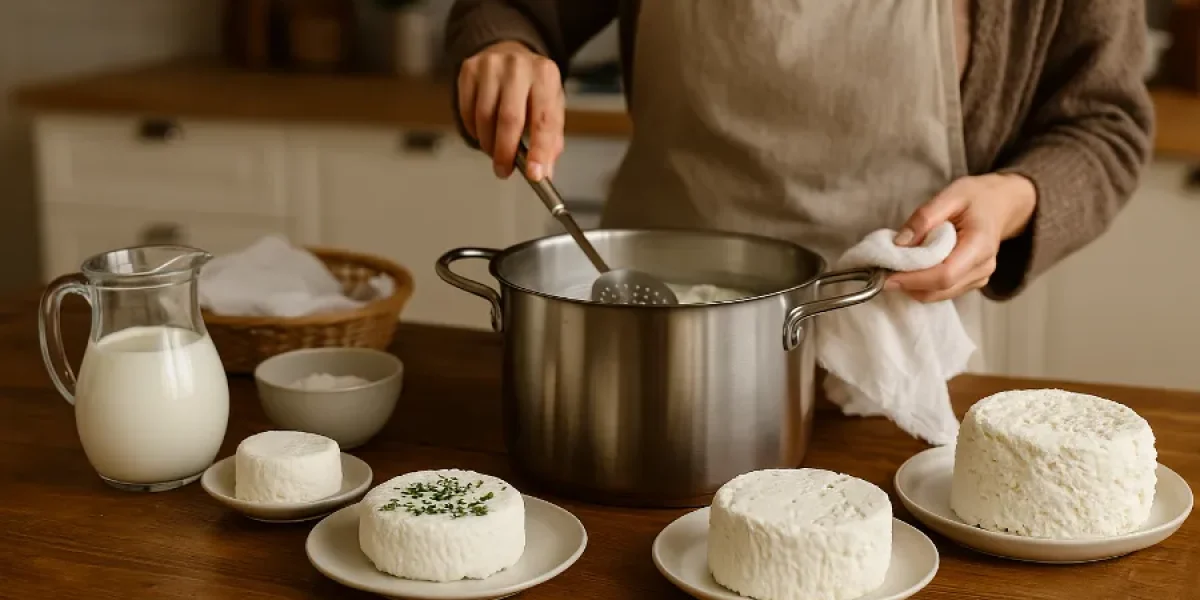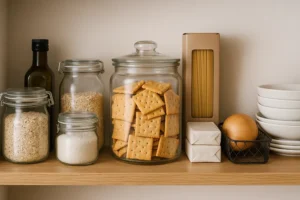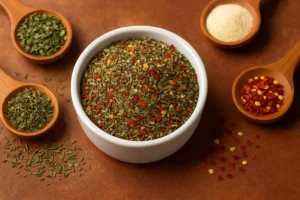If there’s one ingredient that captures the soul of a homestead kitchen, it’s goat cheese. Creamy, tangy, and endlessly versatile, goat cheese transforms even the simplest meal into something special. Whether you’re spreading fresh goat cheese on warm bread or slicing into an aged goat cheese wheel that’s been curing for months, each bite tells a story — one of patience, craft, and the incredible richness of cheese from goat milk.
In this guide, we’ll dive deep into goat cheese recipes for every skill level — from quick and easy chèvre to advanced aged varieties. You’ll learn how to make goat cheese at home using simple tools, understand the science of curd and whey, and explore the unique flavors each cheese style brings to the table.
Why Goat Cheese Deserves a Place in Every Kitchen

Goat milk’s naturally small fat globules, high butterfat, and slightly acidic balance make it perfect for cheesemaking. It yields cheese that’s:
- Easier to digest than cow’s milk cheese
- Naturally creamy without additives
- Full of character — earthy, tangy, and mild all at once
Making homemade goat cheese gives you full control over flavor, texture, and aging. You can create everything from spreadable soft cheeses to firm, crumbly, or deeply complex aged wheels — all starting from the same milk.
How to Make Goat Cheese: The Basics
Before jumping into recipes, it helps to understand the fundamentals of how to make goat cheese. Cheesemaking is both art and science — but at its core, it’s about controlling three things: milk, culture, and time.
Essential Ingredients
- Fresh goat milk — raw or gently pasteurized
- Starter culture — mesophilic (for soft cheeses) or thermophilic (for aged ones)
- Rennet — helps curds form
- Salt — enhances flavor and preservation
- Optional additives: herbs, ash, mold cultures, or spices for flavor variations
Basic Steps
- Warm the milk to the right temperature.
- Add culture to acidify the milk.
- Add rennet to form curds.
- Cut and drain the curds, separating them from the whey.
- Shape, salt, and age the cheese depending on the style you’re making.
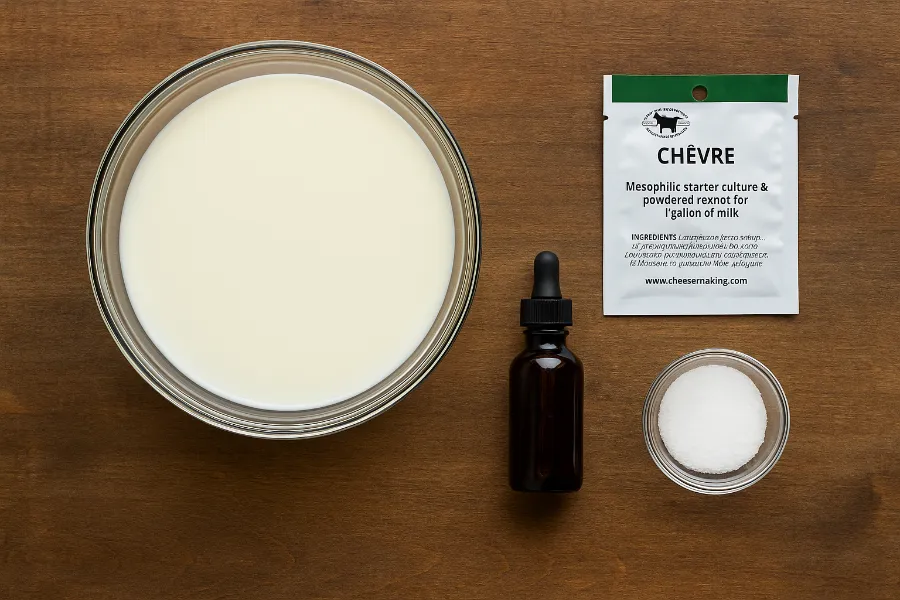
Goat Milk Pasteurization: Preparing the Perfect Base
If you’re using raw milk from your own herd, it’s important to know when and how to pasteurize. Goat milk pasteurization preserves freshness while reducing harmful bacteria.
How to Pasteurize Goat Milk
- Heat milk slowly to 145°F (63°C).
- Hold this temperature for 30 minutes, stirring gently.
- Cool rapidly to below 40°F (4°C).
Pasteurized milk is stable and consistent — ideal for beginners learning the delicate balance of curds and cultures.
Fresh Goat Cheese Recipe (Chèvre)
Keyword Focus: chèvre cheese recipe, fresh goat cheese, creamy goat cheese
Difficulty: Easy
Time: 12–16 hours
Ingredients
- 1 gallon goat milk
- 1 packet chèvre starter culture
- 1/8 teaspoon liquid rennet (optional)
- 1 teaspoon non-iodized salt
Instructions
- Warm milk to 86°F (30°C).
- Stir in the chèvre culture; cover and let sit for 12 hours.
- Once curds form, ladle them into cheesecloth and let drain for 6–10 hours.
- Salt to taste and refrigerate.
Flavor & Texture
This creamy goat cheese has a bright, tangy flavor with a smooth, spreadable consistency. Serve it with honey, fresh herbs, or roasted vegetables for a quick gourmet snack.
Pro Tip: Mix in chopped basil, black pepper, or garlic before chilling for flavored chèvre rounds.
Homemade Goat Cheese (Farmer’s Cheese Style)
Keyword Focus: homemade goat cheese, goat milk cheese recipe, curd and whey
Difficulty: Easy
Time: 8–12 hours
Ingredients
- 1 gallon pasteurized goat milk
- 1/4 teaspoon mesophilic culture
- 1/4 teaspoon rennet
- 1 teaspoon salt
Instructions
- Heat milk to 86°F and add starter culture.
- Add rennet, stir gently, and let sit overnight.
- Cut the curds and pour into cheesecloth to drain.
- Hang the cheesecloth for several hours to let the whey separate.
- Salt and refrigerate.
Flavor & Texture
Slightly tangy and crumbly goat cheese, perfect for sandwiches, baking, or salads. The curds are soft yet structured, offering a balance between spreadable and sliceable.
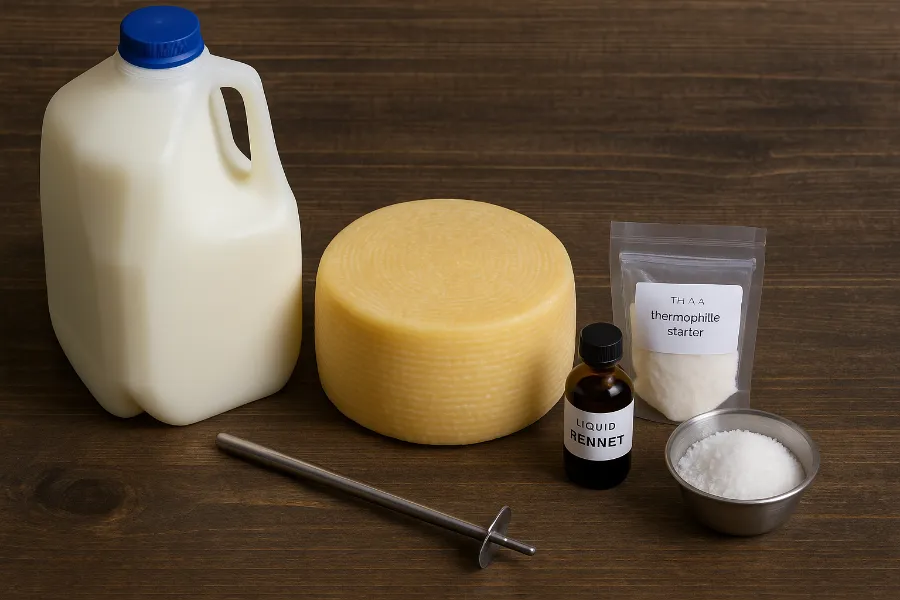
Chevre vs. Farmer’s Cheese: The Curd and Whey Difference
The key to understanding cheese from goat milk lies in the relationship between curd and whey.
- Curds are the solid part (the cheese).
- Whey is the liquid left behind — rich in protein and nutrients.
In soft cheeses like chèvre, curds are left delicate and moist. In firmer cheeses like feta or gouda, they’re cut smaller and drained longer to remove more whey, creating a hard goat cheese texture.
Goat Feta Cheese Recipe (Brined and Crumbly)
Keyword Focus: crumbly goat cheese, goat milk cheese recipe
Difficulty: Moderate
Time: 2 days + aging
Ingredients
- 1 gallon goat milk
- 1/4 teaspoon mesophilic starter
- 1/4 teaspoon rennet
- 2 tablespoons salt
- Brine: 1 quart water + 1/4 cup salt
Instructions
- Heat milk to 86°F and add starter.
- Let sit 1 hour, then add rennet.
- Cut curds into ½-inch cubes and rest for 20 minutes.
- Scoop into molds or cloth, drain overnight.
- Slice into cubes and soak in brine for 3–5 days.
Flavor & Texture
Salty, tangy, and beautifully crumbly goat cheese — perfect for salads, pizzas, or Mediterranean dishes. The longer it brines, the stronger its bite.
Goat Blue Cheese Recipe: Bold and Tangy Perfection
Keyword Focus: goat blue cheese, aged goat cheese
Difficulty: Advanced
Time: 3–4 months aging
Ingredients
- 2 gallons goat milk
- Penicillium roqueforti (blue mold culture)
- Mesophilic starter
- Rennet
- Salt
Instructions
- Warm milk to 86°F and add cultures.
- Add rennet and let curds form.
- Ladle curds gently into molds (don’t press).
- Salt lightly each day for 4–5 days.
- Pierce cheese with a sterile skewer to allow air to form blue veins.
- Age at 50–55°F and high humidity for at least 90 days.
Flavor & Texture
Creamy yet crumbly, goat blue cheese combines earthy, spicy, and tangy flavors. Serve with honey, pears, or walnuts for a gourmet experience.
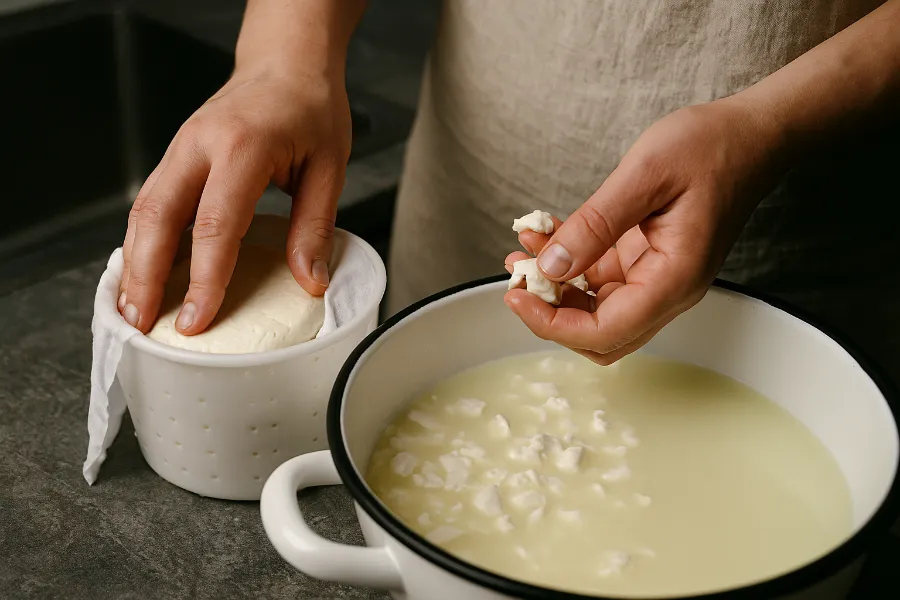
Aged Goat Cheese Recipe (Tomme or Gouda Style)
Keyword Focus: aged goat cheese, hard goat cheese, goat milk pasteurization
Difficulty: Advanced
Time: 4–8 weeks aging
Ingredients
- 2 gallons goat milk
- Thermophilic starter
- ½ teaspoon rennet
- 1 tablespoon salt
Instructions
- Warm milk to 90°F and add starter.
- Add rennet and rest 45 minutes.
- Cut curds into small cubes, stir gently, and heat slowly to 105°F.
- Drain part of the whey, replace with warm water (“washing the curds”).
- Press curds in a mold for 12 hours.
- Brine for 24 hours, dry, and age in a cool, humid space for 4–8 weeks.
Flavor & Texture
Firm, buttery, and slightly sweet with an earthy tang — a true hard goat cheese that improves with time. Ideal for slicing, grating, or pairing with wine and fruit.
Creamy Goat Cheese Spread Recipe
Keyword Focus: creamy goat cheese, goat milk cheese recipe
Difficulty: Easy
Time: 6 hours
Ingredients
- 1 quart fresh goat milk
- 2 tablespoons lemon juice
- Pinch of salt
- Optional: chives, dill, garlic
Instructions
- Heat milk to 180°F, add lemon juice, and stir until curds form.
- Strain through cheesecloth for 4–6 hours.
- Mix with salt and herbs for flavor.
Flavor & Use
Silky and rich, this creamy goat cheese spread is perfect for toast, crackers, or as a base for dips and dressings.
Hard Goat Cheese vs. Fresh Goat Cheese: What’s the Difference?
| Type | Texture | Flavor | Aging Time | Best For |
|---|---|---|---|---|
| Fresh Goat Cheese (Chèvre) | Soft, creamy | Tangy, light | None | Spreads, salads |
| Crumbly Goat Cheese (Feta) | Firm, salty | Sharp, brined | 5–10 days | Mediterranean dishes |
| Aged Goat Cheese (Gouda/Tomme) | Hard, sliceable | Buttery, nutty | 4–8 weeks | Wine pairing, cooking |
| Goat Blue Cheese | Creamy, veined | Earthy, bold | 3+ months | Gourmet boards |
Each type of cheese tells a different story of texture and time. Start with fresh goat cheese for instant satisfaction, or dive into aged goat cheese for a deeper, more complex reward.
Storing and Serving Goat Cheese
Storage Tips
- Soft cheeses: Store in airtight containers up to 7 days.
- Brined cheeses: Keep submerged in brine for up to 3 months.
- Aged cheeses: Wrap in wax or cheese paper, not plastic, and refrigerate.
Serving Ideas
- Crumble over roasted beets or arugula salads.
- Spread on baguettes with fig jam.
- Pair aged varieties with red wine or honey.
- Melt into pasta or pizza for creamy richness.
Goat Cheese Troubleshooting: Common Issues
| Problem | Possible Cause | Fix |
|---|---|---|
| Curds too soft | Too little rennet | Add slightly more next batch |
| Sour flavor | Over-acidified milk | Shorten culturing time |
| Bitter taste | Over-aged or poor sanitation | Age less / clean tools |
| Dry texture | Overheated curds | Keep temp steady |
The Magic of Curd and Whey: Nothing Goes to Waste
Every cheesemaking session leaves you with plenty of whey — the golden liquid that’s rich in protein and minerals. Don’t toss it! You can use it to:
- Feed to pigs or chickens for nutrition
- Add to bread dough for flavor
- Use in soups, smoothies, or plant fertilizer
Whey is nature’s reminder that nothing in homesteading truly goes to waste.
Final Thoughts: The Joy of Homemade Goat Cheese
From the first soft curd to the final aged wheel, goat cheese recipes are a journey in patience, creativity, and connection to your food. You start with simple ingredients — milk, culture, salt — and end with something greater than the sum of its parts.
Making homemade goat cheese isn’t just a kitchen experiment. It’s a skill that bridges generations, a way to bring authentic flavor to your table, and a small act of sustainable living that rewards you in every delicious bite.
So grab that pot, heat up your goat milk, and start your first batch today — because the best goat cheese is the one made with your own hands.
FAQs
You’ll need fresh goat milk, starter culture, rennet, salt, and basic tools like a pot, thermometer, and cheesecloth. These essentials are enough to make both soft and aged cheeses right in your kitchen.
Yes, you can use store-bought goat milk as long as it’s not ultra-pasteurized. Ultra-pasteurization changes the proteins and prevents curds from forming properly.
Soft cheeses like chèvre or ricotta take 12–24 hours, while aged varieties like gouda or blue cheese can take several weeks to months to mature. Patience adds depth and flavor.
Fresh goat cheese is soft, creamy, and tangy, ready to eat within a day. Aged goat cheese develops a firmer texture and nutty flavor over time, ideal for slicing or grating.
Slowly heat the milk to 145°F, hold for 30 minutes, and cool quickly to 40°F. This preserves the flavor while making the milk safe and consistent for cheese production.
You can use whey in soups, bread, smoothies, or as animal feed and garden fertilizer. It’s packed with protein and beneficial minerals, so don’t throw it away!
Soft cheeses should be kept in airtight containers for up to a week, while aged or brined cheeses can last months if stored properly in cool, humid conditions.

